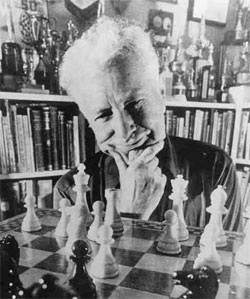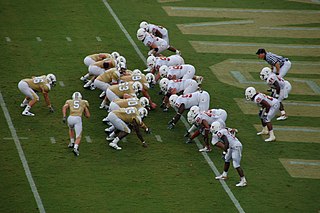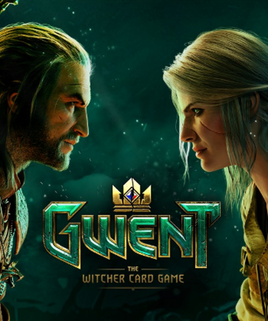
The Elo rating system is a method for calculating the relative skill levels of players in zero-sum games such as chess or esports. It is named after its creator Arpad Elo, a Hungarian-American physics professor.
A tournament is a competition involving at least three competitors, all participating in a sport or game. More specifically, the term may be used in either of two overlapping senses:
- One or more competitions held at a single venue and concentrated into a relatively short time interval.
- A competition involving a number of matches, each involving a subset of the competitors, with the overall tournament winner determined based on the combined results of these individual matches. These are common in those sports and games where each match must involve a small number of competitors: often precisely two, as in most team sports, racket sports and combat sports, many card games and board games, and many forms of competitive debating. Such tournaments allow large numbers to compete against each other in spite of the restriction on numbers in a single match.

Promotion and relegation is used by sports leagues as a process where teams can move up and down among divisions in a League system, based on their performance over a season. Leagues that use promotion and relegation systems are often called open leagues. In a system of promotion and relegation, the best-ranked team(s) in a lower division are promoted to a higher division for the next season, and the worst-ranked team(s) in the higher division are relegated to the lower division for the next season. During the season, teams that are high enough in the league table that they would qualify for promotion are sometimes said to be in the promotion zone, and those at the bottom are in the relegation zone.

The FIFA Men's World Ranking is a ranking system for men's national teams in association football, led by Argentina as of July 2024. The men's teams of the member nations of FIFA, football's world governing body, are ranked based on their game results with the most successful teams being ranked highest. The rankings were introduced in December 1992, and eight teams have held the top position, of which Brazil have spent the longest time ranked first.
The FIFA Women's World Ranking is a ranking system for women's national teams in association football published by the international governing body FIFA. As of August 2024, the USWNT is ranked #1.

The Montserrat national football team represents Montserrat in international football. Football is the second most popular sport in Montserrat, after cricket. The team plays at the Blakes Estate Stadium. The Montserrat football team was formed in 1973, and has entered the World Cup qualifiers since the 2002 edition, being eliminated in the first round on each occasion.
Jeff Sagarin is an American sports statistician known for his development of a method for ranking and rating sports teams in a variety of sports. His Sagarin Ratings have been a regular feature in the USA Today sports section from 1985 to 2023, have been used by the NCAA Tournament Selection Committee to help determine the participants in the NCAA Men's Division I Basketball Championship tournament since 1984, and were part of the college football Bowl Championship Series throughout its history from 1998 to 2014.
Masterpoints or master points are points awarded by bridge organizations to individuals for success in competitive bridge tournaments run under their auspices. Generally, recipients must be members in good standing of the issuing organization. At the international level, competitions and point awards are administered by the World Bridge Federation (WBF); its affiliates at the multi-national level, such as the American Contract Bridge League (ACBL), also issue points as do more local organizations such as the English Bridge Union (EBU), and the Deutsche Bridge Verband (DBV) and independent ones such as the American Bridge Association (ABA).

There are various systems of Go ranks and ratings that measure the skill in the traditional board game Go. Traditionally, Go rankings have been measured using a system of dan and kyu ranks. Especially in amateur play, these ranks facilitate the handicapping system, with a difference of one rank roughly corresponding to one free move at the beginning of the game. This system is also commonly used in many East Asian martial arts, where it often corresponds with a belt color. With the ready availability of calculators and computers, rating systems have been introduced. In such systems, a rating is rigorously calculated on the basis of game results.
A Swiss-system tournament is a non-eliminating tournament format that features a fixed number of rounds of competition, but considerably fewer than for a round-robin tournament; thus each competitor does not play all the other competitors. Competitors meet one-on-one in each round and are paired using a set of rules designed to ensure that each competitor plays opponents with a similar running score, but does not play the same opponent more than once. The winner is the competitor with the highest aggregate points earned in all rounds. With an even number of participants, all competitors play in each round.

The American Contract Bridge League (ACBL) is a governing body for contract bridge in the United States, Canada, Mexico, and Bermuda. It is the largest such organization in North America having the stated mission "to promote, grow and sustain the game of bridge and serve the bridge-related interests of our Members." Its major activities are:
This page is a glossary of tennis terminology.

A sports rating system is a system that analyzes the results of sports competitions to provide ratings for each team or player. Common systems include polls of expert voters, crowdsourcing non-expert voters, betting markets, and computer systems. Ratings, or power ratings, are numerical representations of competitive strength, often directly comparable so that the game outcome between any two teams can be predicted. Rankings, or power rankings, can be directly provided, or can be derived by sorting each team's ratings and assigning an ordinal rank to each team, so that the highest rated team earns the #1 rank. Rating systems provide an alternative to traditional sports standings which are based on win–loss–tie ratios.

The Golden Team refers to the Hungary national football team of the 1950s. It is associated with several notable matches, including the quarter-final against Brazil, semi-final and final of the 1954 FIFA World Cup. The team inflicted notable defeats on then-footballing world powers Uruguay, Soviet Union, England, Germany, Brazil and Italy before the 1956 Hungarian Revolution caused the breakup of the side. The Golden Team was also known by different nicknames, such as the Mighty Magyars, the Magical Magyars, and the Magnificent Magyars.
A chess rating system is a system used in chess to estimate the strength of a player, based on their performance versus other players. They are used by organizations such as FIDE, the US Chess Federation, International Correspondence Chess Federation, and the English Chess Federation. Most of the systems are used to recalculate ratings after a tournament or match but some are used to recalculate ratings after individual games. Popular online chess sites such as Chess.com, Lichess, and Internet Chess Club also implement rating systems. In almost all systems, a higher number indicates a stronger player. In general, players' ratings go up if they perform better than expected and down if they perform worse than expected. The magnitude of the change depends on the rating of their opponents. The Elo rating system is currently the most widely used. The Elo-like ratings systems have been adopted in many other contexts, such as other games like Go, in online competitive gaming, and in dating apps.

Gwent: The Witcher Card Game is a 2018 digital collectible card game by CD Projekt. It was released free-to-play first for Windows, PlayStation 4, and Xbox One in 2018, and for iOS in 2019, Android in 2020, and macOS in 2021. Gwent is derived from the card game of the same name featured in Andrzej Sapkowski's The Witcher novels and playable in The Witcher 3: Wild Hunt video game. A standalone single-player expansion, Gwent: Rogue Mage, released in 2022 to mixed reception.
Elo hell is a video gaming term used in MOBAs and other multiplayer online games with competitive modes. It refers to portions of the matchmaking ranking spectrum where individual matches are of poor quality, and are often determined by factors such as poor team coordination which are perceived to be outside the individual player's control. This ostensibly makes it difficult for skilled players to "climb" up the matchmaking ranking, due to the difficulty of consistently winning games under these conditions. Its existence in various games has been debated, and some game developers have called it an illusion caused by cognitive bias.
The World Football Elo Ratings are a ranking system for men's national association football teams that is published by the website eloratings.net. It is based on the Elo rating system but includes modifications to take various football-specific variables into account, like the margin of victory, importance of a match, and home field advantage. Other implementations of the Elo rating system are possible and there is no single nor any official Elo ranking for football teams.

The StarLadder Major: Berlin 2019, also known as StarLadder Major 2019 or Berlin 2019, was the fifteenth Counter-Strike: Global Offensive (CS:GO) Major Championship. It was held in Berlin, Germany from August 23 to September 8, 2019. Fourteen teams qualified for this Major based on their placement at the previous Major, Katowice 2019, while another ten teams qualified from their respective regional qualifiers. It featured a US$1,000,000 prize pool, the eighth consecutive Major with this prize pool. It was also the first time the Ukrainian-based organization StarLadder. along with its long-term Chinese partner ImbaTV, hosted a Major.
Boosting is a method by which low-ranked players in online multiplayer games, such as first-person shooters and massively multiplayer online role-playing games (MMORPGs), hire more skilled players to artificially increase their gaming account rank or winning positions. Boosting is rarely allowed as part of a game's terms of service, and while legal in most countries, boosted accounts are sometimes banned or reset if detected. In South Korea, it was declared a criminal offense in 2018, leading various companies to tighten their policies on it. The act of boosting negatively impacts game balance by allowing unskilled players to lower the quality of high-ranking play, making the game less viable and enjoyable. However, the extent of the crackdown on boosting has been debated, with some calling it not severe enough to merit criminal penalties.












